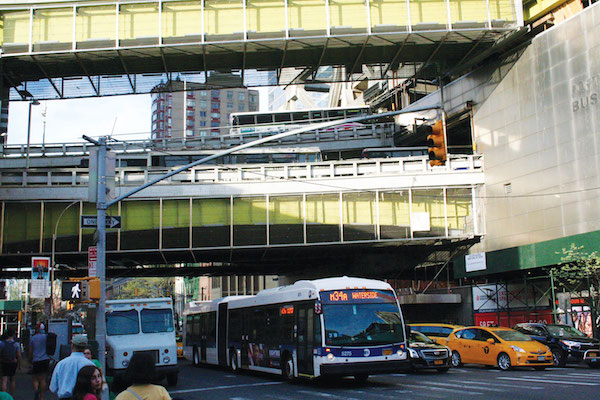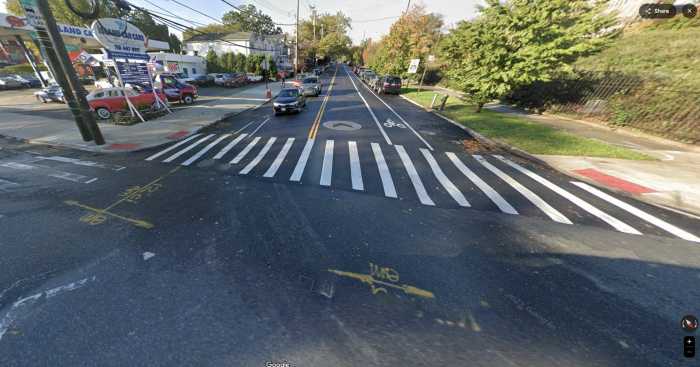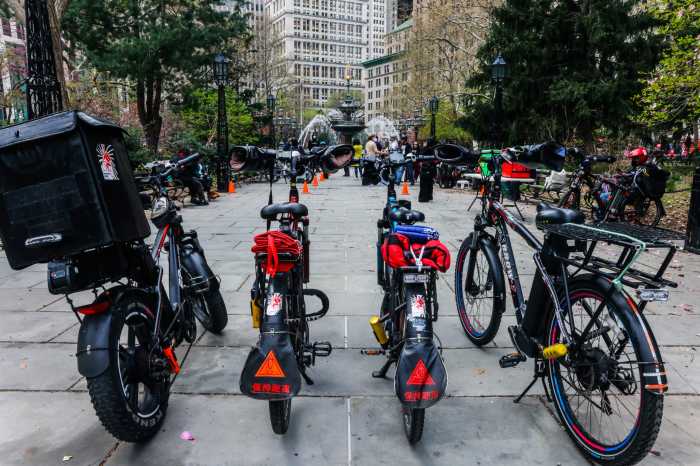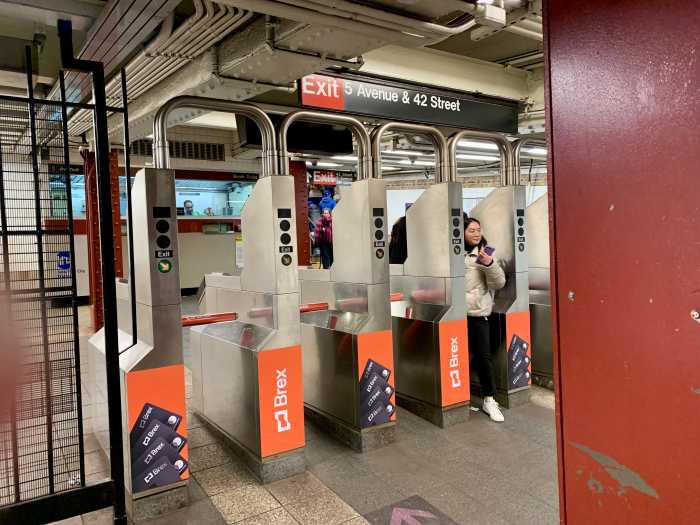
BY EILEEN STUKANE | The sprawling entity that is the Port Authority of New York and New Jersey has slowed the forward march of its planned bus terminal expansion in Hell’s Kitchen by forming a working group with representatives from both states and reaching out for community engagement in the effort.
The working group emerges after six months of contentious debate over the Port Authority’s spring announcement that it planned to expand the bus terminal, currently located between Eighth and Ninth Avenues, from West 40th to West 42nd Street. Without input from elected officials or Community Board 4, the Port Authority proposed using eminent domain — the process by which the government takes control of private property for public works projects — to seize blocks of buildings, a move that would upend lives and destroy vital neighborhood institutions.
With the help of local and state elected officials, CB4 immediately mobilized, holding a town hall meeting attended by Port Authority officials, who then withdrew their initial design and oversaw a competition for architectural ideas.
Only one of the competition’s five finalists — who separately proposed plans costing between $3 billion and $15 billion — included eminent domain in its concept, but the community was still not invited to participate in the process. Community leaders and elected officials boycotted a September meeting to review the proposals from the five finalists, citing continued lack of community involvement on the Port Authority’s part.
That’s when change happened.
Following the boycott, the agency established the New York/ New Jersey Working Group, which includes eight New Yorkers: Congressmember Jerrold Nadler, Manhattan Borough President Gale Brewer, State Senator Brad Hoylman, State Assemblymembers Richard Gottfried and Linda Rosenthal, City Councilmember Corey Johnson, CB4 chair Delores Rubin, and Community Board 5 chair Vikki Barbero.
The five finalists’ designs remain a part of the discussion, though none is likely to be built as presented.
To gain greater insight into where the process currently stands, this reporter sat down with Betty Mackintosh, who heads up CB4’s Port Authority Working Group, and Christine Berthet, the co-chair of the CB4 Transportation Planning Committee. Michael Lavery, the Port Authority’s government and community relations representative, declined to be interviewed for this article.
According to the Port Authority, 220,000 passengers, involving 7,000 bus movements, pass through the Hell’s Kitchen bus terminal each workday. By 2040, the number of passengers is estimated to increase by between 35 and 51 percent, to as many as 337,000 passengers.
The West Side bus terminal, built 65 years ago, will not be able to handle this increased capacity. In fact, it can barely manage the hundreds of thousands of people it has passing through it today, and an increasing number of buses are overflowing onto the streets, parked in lines along the curbs of Hell’s Kitchen.
“The CB4 district, which is larger than our study area, has the third worst pollution in the city according to the New York City Department of Health,” Mackintosh stated.
Berthet said, “The congestion in this neighborhood is double what the average is in the city.”
Clearly a solution must be found.
Observers agree that representatives from the two states sitting at the same table to resolve their transportation problems together represents a major breakthrough. Some proposals for solving the mess at the current bus terminal involve the staging of buses on the other side of the Hudson River in New Jersey. As well, it has become clear that what’s at stake is greater than the expansion of one bus terminal.
A Port Authority Trans-Hudson Commuting Capacity Study released in September noted that the demand placed on the bus terminal could be reduced by other transportation initiatives. Among them are the Gateway Program that would increase track, tunnel, bridge, and rail station capacity — eventually creating four mainline tracks between Newark and Manhattan’s Penn Station with a new Hudson River tunnel. Expanded Trans-Hudson ferry services and a 7 train subway line extension to Secaucus are also under consideration.
“The study depicts a system where the bus terminal is just one piece,” Berthet noted. “The system goes into the Lincoln Tunnel, all the way to 495, where the buses are lining up and coming in. If you are going to double the size of the bus terminal, if you don’t double the size of the Lincoln Tunnel, what are you going to do? The whole system needs to be scaled up at the same time. From the community’s standpoint, it’s very important where the terminal is — but then from a transportation point of view, let’s not build an enormous terminal if the structure is not scaled appropriately. The Port Authority is starting to understand that it needs to think as a system. I think this is a very big step in the right direction.”
The Port Authority owns the bus terminal’s land, but it also owns other plots of land on the West Side. The CB4 Port Authority Working Group is busy mapping out the community and locating the agency’s properties.
“We’re also going to have some maps showing issues and problems we have, vehicular traffic, bus traffic, buses lining the curbside in the community district,” Berthet explained. “We’re systematically studying the area so that we understand what we’re doing when someone says, ‘Why not put a Port Authority building or garage in this or that location?’”
The working group’s maps and graphics will encompass the area from Eighth Avenue to 12th Avenue, between 33rd and 42nd Street.
“We will describe what the land uses are there ,” Mackintosh noted. “There’s a lot of Port Authority property there. We’re going to show the residential areas, the affordable housing.”
She continued, “I think this bus terminal is one of the largest in the world in terms of people. So you’re trying to put one of the biggest things in the world into the smallest footprint. That’s where you have to think outside the box.”
CB4 plans community meetings going forward to maintain the flow of information to residents and business owners, to sustain awareness and alertness, and to strengthen the relationship between the community and the Port Authority. This type of project, Berthet noted, “is going to be long, very expensive, very complicated, and you never quite know whether the right solution is going to emerge because politics become involved.”
Still, Mackintosh and Berthet are optimistic.
“I think the effort that we put forth in the spring was very effective,” Mackintosh said, adding, “The unification of our elected officials with CB4 was extraordinary. There wasn’t anyone marching to a different drummer. That’s pretty amazing, and then the fact that the Port Authority shifted to a different process, it’s pretty miraculous.”
“I agree,” Berthet said, “and that the electeds of New York and New Jersey are in the same room, that’s really unusual. Getting everybody in one room talking about a solution for both sides, to me, is very exciting and very big.”
On Saturday, November 19, 9:30 a.m.–4 p.m., CB4’s Port Authority Working Group will host a panel discussion and present a preview of a slide show that will be more formally presented at a December 6 town hall meeting. Saturday’s meeting takes place at the Fordham University School of Law at 150 West 62nd Street.
The formal slide show presentation takes place on Tuesday, December 6 at 6:30 p.m. at Metro Baptist Church, 410 West 40th Street. The discussion that evening will focus on how to integrate community needs with the Port Authority’s expansion plans.





































